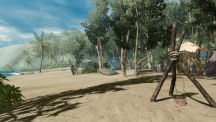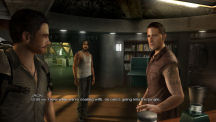Do you
watch TV? News? Sports? Soaps? Comedies? How about major network dramas? I
don't bother with much other than a bit of motorsports and sci-fi, so
“Lost” is just about as far off my radar as, well, as the island on said
TV show. This puts me in an interesting situation with Lost: Via Domus.
I'm well aware that the TV program has achieved something of a following
to say the least, including a number of my work colleagues. But of the
characters, backstory and plotlines I have no knowledge whatsoever. So let
me approach the game Lost: Via Domus from a position of complete
ignorance, and please bear with me if I make any glaring mis-assumptions
or gaffes.
So, having made my ignorance
quite clear, next comes the really tricky question:
What
is it?
Well, for now, I'm not going
to answer that, because a) it would give too much away at this early
stage, and b) I want to get a chance to talk about the game before I put
anyone off with a pigeonholing of the game too early in the piece. Please,
bear with me, I hope it'll be worth it.
Is there a plot?
The basic premise of the TV
series is that an airliner, Oceanic Flight 815, has crash-landed on a
mysterious island somewhere in the South Pacific. There's a deadly monster
in the jungle, and several groups of people on the island, including the
crash survivors, whose various sets of motivations are not entirely clear.
The game Lost: Via Domus
is concerned with one of the crash survivors whose story has not yet been
told in the TV series, although I gather that this thread is
contemporaneous with early parts of the series. I won't give the name
away, as figuring it out is one of the puzzles in the game. However, you
will come across many of the characters that are in the TV series;
for example, Jack, Kate, Charlie, Hurley, Sayid, Locke and Ben all appear,
as do several other characters. Some are sources of information, some will
help you solve puzzles, others provide opportunities for trade, and still
more provide the backstory for how your character came to be on Oceanic
Flight 815.
The arc of the game takes
place over seven 'episodes' and to reinforce that format, each episode
begins with a 'Previously on Lost' cut-scene.
Notable Features
The character you control in
Lost: Via Domus is a photographer – this much becomes clear very
early in the game. This has given the developers a rather novel way to
deal with his amnesia: via the vehicle of flash-backs focused on the need
to take a photograph of specific (but unspecified, except by a torn up
photo) elements in a scene played out before you. Wow, this is really
rather tricky to explain!
Suffice it to say, you have
to identify the salient points in a short memory sequence, frame them in a
photo, choose the right moment, and focus it correctly. This gives you
access to memories that move the plot onwards. This is not as hard as it
sounds, at least for the first couple of shots. The obscurity and
complexity of the shots becomes greater as the game progresses. However,
the really nice part about this feature is that the short memory sequence
keeps repeating, so you can try again and again to get it right. And you
get hints about what's missing in your shot if you miss it, be it the
timing, the focus or the objects in view. I enjoyed these sequences. They
provide a novel challenge that's about more than just clicking on every
inventory item until one fits, and they fit the plot well.
How
do you play?
Lost: Via Domus
is primarily played from the over-the-shoulder perspective – what I like
to call 'second person.' It's not the first-person view of FPS
(first-person shooter) games, nor is it the third-person view of adventure
games like Grim Fandango or Dreamfall. It's much closer to
the perspective used in the Tomb Raider and recent Indiana Jones
games. You control the game with the keyboard and mouse: movement by W, A,
S, and D, with other keys for running (left shift), inventory (I), logbook
(L), first-person view (C), aiming the gun (ctrl) and talking to people or
activating hotspots (space and enter), and using your selected inventory
item (E). The viewpoint is controlled by the mouse (except in the timed
action sequences when the camera automatically follows your character).
When you come across an on-screen puzzle, like the circuit board puzzles
(of which there are a number), the interface takes a point-n-click form.
The actions available at any
given time (other than those permanently available, like movement), are
listed in the bottom left corner of the screen.
The inventory has a limited
number of slots, and some items will stack in a slot, but others take a
whole slot to themselves. There are no explicit inventory-combining
puzzles, though some items won't work unless you have others in your
possession.
The interface is affected by
the usual Options screens. The save system in Lost: Via Domus is
very simple: it’s automatic. After each subsection of the plot -- a
session of character interactions on the beach, for example -- the game
will save your progress. However, the only indication you get is an icon
that reminds me of an old reel-to-reel tape deck in the top right corner
(and I suspect many people younger than myself won’t even recognize it as
such).
The graphics options are all
controlled using a setup program available when you start the game, not
from within the running game. One tab in the setup program shows how your
computer stacks up against the minimum requirements of the game. This
gives you a nice green tick/red cross against each key requirement,
showing whether you should expect the game to run successfully or
otherwise. However, it is not so accurate in indicating whether you can
use high resolution graphics modes or not – this seems to have been left
as an experimental exercise for the user.
Options available in-game
include choosing to use the keyboard or a gamepad, customising the keys
used, subtitles, inversion of the mouse actions, screen brightness and
sound volumes.
The puzzles in Lost: Via
Domus are quite an interesting selection. There are navigation
puzzles, timed sequences, logical IQ-like tests, circuit boards to repair
and dialog puzzles. Some of the puzzles pit you against the shadow monster
and, thanks largely to shortish time scales and dramatic music and sound
effects, these are rather tense affairs. This game is not for the easily
frightened or for nyctophobes. However, it is not gruesome, so by and
large, blood is not the problem. The game has a Teen rating from the ESRB.
I'll let you take from that what you will.
Conclusions
Lost: Via Domus
is one of those games that falls firmly in the hybrid action adventure
gap. There, I've said it, and perhaps that will curse the game to the
limbo of “well it's not the sort of game I like”-land.
It's certainly not a
point-n-click adventure like the Undercover: Operation Wintersun,
even though it's played from the third-person point of view. Nor is it a
first-person shooter like Half Life, even though there is a
first-person view, and you own a gun (and use it) later in the story.
However, it does bear some comparisons to Tomb Raider in that there are
plenty of action sequences, you can die (often), you do have to jump over
things, but you also have to use your brain to solve puzzles.
If you look at Lost: Via
Domus from the point of view that it is an adventure game, then the
frequency with which you will die is somewhat distressing. I won't
believe anyone who says they manage to get through this game without being
caught by the shadow monster at least once -- there are just too many
opportunities for this to happen. On the other hand, if you classify this
game as an action game, it's surprising how easy it is to avoid getting
shot. After all, there isn't a health bar, nor are there many times when
you have no alternative but to shoot things – I can think of only two
occasions when using the gun is mandatory.
Finally, I have to give some
reasoning for the grade I've given below. Lost: Via Domus is a good
game, let down by some elementary shortcomings. First the strong points:
-
The graphics are
excellent – detailed, colourful, varied, and, as far as I can tell from
official photographs, very accurate in their portrayal of the characters
from the TV series.
-
Sounds and music are
moody, atmospheric, scary, or relaxed as appropriate.
-
The voice acting is
excellent.
-
The gameplay – the
puzzles, the action sequences and so on – is not very difficult to this
experienced gamer, though I think people outside their usual comfort
zone will suffer with some areas.
-
The story is strong, and
moves along nicely throughout the seven 'episodes,' and doesn't make
assumptions about whether you've seen the TV program at all.
Now those shortcomings:
-
Within the episodes I've
already mentioned, the game is broken down into a number of smaller
sections. One might be an action sequence in the jungle, and another
might be solving a circuit panel puzzle. The problem is that each of
these is punctuated by a long loading screen.
-
Every time you load the
game, you get a 'Previously on Lost' video summarising the story so far
(not just the last episode). This is a great idea, but if you
have to reload the game a number of times for whatever reason (perhaps
Real Life™ gets in the way), you can end up sitting through the same
'Previously...' a number of times, with no ability to skip it.
Personal opinion based upon nothing more than preference coming up: all
cut scenes should be viewable as many times as the player wants, and if
they can be repeated, should always be skippable.
-
The circuit board puzzle
is overused, and although it's a fun challenge a few times, by the time
I finished the game I think I'd done about twenty of them. Okay, really it's
a lot less than that, but you know what I mean. Just because an idea
makes a good puzzle does not mean you should use it for every door you
can think of!
Time to stop the whinging.
Overall, I enjoyed the experience of playing Lost: Via Domus,
though it could have done with being a bit longer. I might even see if I
can borrow the DVD of Season 1 from a friend to try the real thing.
Grade: B+
What
do you need to play it?
Minimum Requirements:
-
Microsoft
Windows® XP (Service Pack 2) or Vista®
-
AMD Athlon™
MP 2400+ 2.0 GHz or Intel® Pentium® 4C 2.4 GHz processor
-
1 GB RAM
-
128 MB
DirectX® 9.0c–compliant, Shader 3.0–enabled video card
-
DirectX
9.0c-compliant sound card
-
DirectX
9.0c (included on disc)
-
4x DVD-ROM
-
5.0 GB Hard Drive space
free
Recommended Requirements,
where different from above.
-
P4 3.5 GHz
or Core™ 2 Duo 2.5 GHz processor
-
2 GB RAM
-
256 MB
DirectX® 9.0c–compliant, Shader 3.0–enabled videocard
-
6.0 GB free
(I used a custom built Win
XP Pro SP2, AMD Athlon 64 3500+, 1024 MB RAM, and ATI X1950 Pro 512MB
video card,)
March 2008
design copyright ©
2008
GameBoomers
Group



